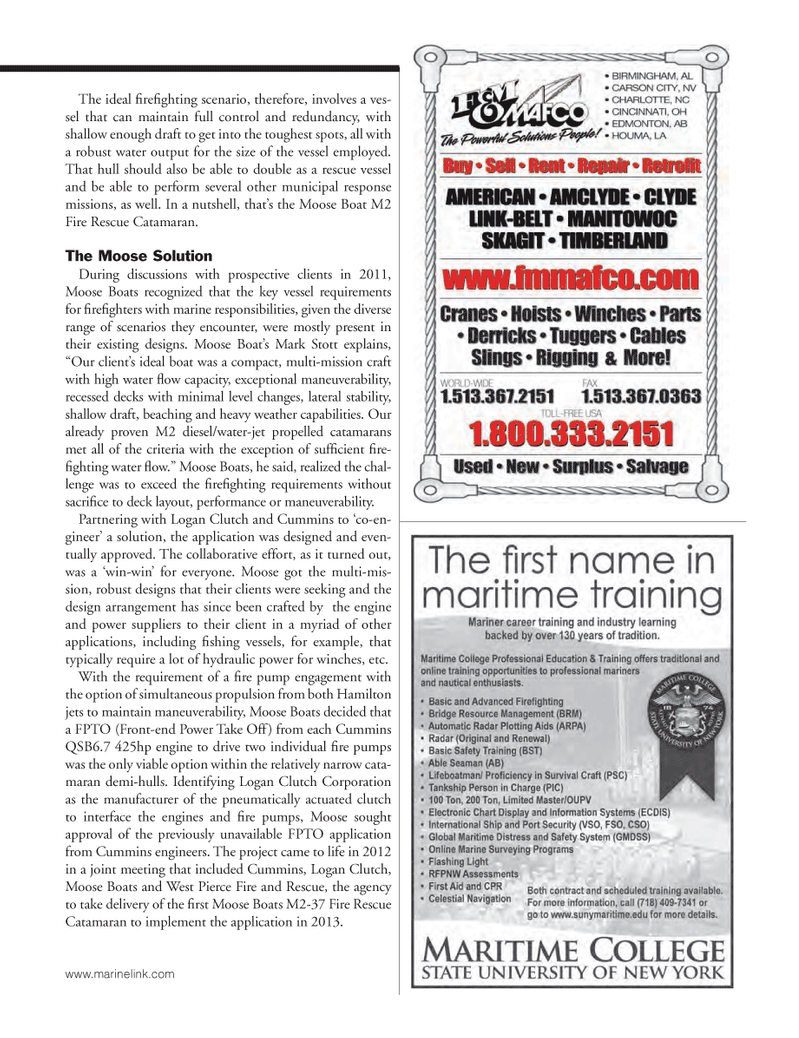
Page 41: of Marine News Magazine (September 2014)
Inland Waterways
Read this page in Pdf, Flash or Html5 edition of September 2014 Marine News Magazine
The ideal Þ reÞ ghting scenario, therefore, involves a ves- sel that can maintain full control and redundancy, with shallow enough draft to get into the toughest spots, all with a robust water output for the size of the vessel employed. That hull should also be able to double as a rescue vessel and be able to perform several other municipal response missions, as well. In a nutshell, thatÕs the Moose Boat M2 Fire Rescue Catamaran. The Moose SolutionDuring discussions with prospective clients in 2011, Moose Boats recognized that the key vessel requirements for Þ reÞ ghters with marine responsibilities, given the diverse range of scenarios they encounter, were mostly present in their existing designs. Moose BoatÕs Mark Stott explains, ÒOur clientÕs ideal boat was a compact, multi-mission craft with high water ß ow capacity, exceptional maneuverability, recessed decks with minimal level changes, lateral stability, shallow draft, beaching and heavy weather capabilities. Our already proven M2 diesel/water-jet propelled catamarans met all of the criteria with the exception of sufÞ cient Þ re- Þ ghting water ß ow.Ó Moose Boats, he said, realized the chal- lenge was to exceed the Þ reÞ ghting requirements without sacriÞ ce to deck layout, performance or maneuverability. Partnering with Logan Clutch and Cummins to Ôco-en- gineerÕ a solution, the application was designed and even- tually approved. The collaborative effort, as it turned out, was a Ôwin-winÕ for everyone. Moose got the multi-mis- sion, robust designs that their clients were seeking and the design arrangement has since been crafted by the engine and power suppliers to their client in a myriad of other applications, including Þ shing vessels, for example, that typically require a lot of hydraulic power for winches, etc. With the requirement of a Þ re pump engagement with the option of simultaneous propulsion from both Hamilton jets to maintain maneuverability, Moose Boats decided that a FPTO (Front-end Power Take Off) from each Cummins QSB6.7 425hp engine to drive two individual Þ re pumps was the only viable option within the relatively narrow cata- maran demi-hulls. Identifying Logan Clutch Corporation as the manufacturer of the pneumatically actuated clutch to interface the engines and Þ re pumps, Moose sought approval of the previously unavailable FPTO application from Cummins engineers. The project came to life in 2012 in a joint meeting that included Cummins, Logan Clutch, Moose Boats and West Pierce Fire and Rescue, the agency to take delivery of the Þ rst Moose Boats M2-37 Fire Rescue Catamaran to implement the application in 2013.www.marinelink.com MN Sept14 Layout 32-49.indd 41MN Sept14 Layout 32-49.indd 418/20/2014 11:38:01 AM8/20/2014 11:38:01 AM

 40
40

 42
42
